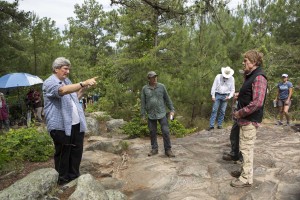
A Walk in the Woods is a buddy road picture based on the true story of writer Bill Bryson (Robert Redford) who decides to hike the Appalachian trail accompanied by an old friend, Stephen Katz (Nick Nolte), that he has not seen in over 30 years.
Film and television director Ken Kwapis (He’s Not That Into You) was drawn to the fundamental optimism of the script and the issues of lost time and past friendships that slip away. Although the plot was not complicated, the storytelling challenge hinges upon how involved the audience is with these two men. “The film lives or dies based upon the performances that Redford and Nolte give,” said Kwapis.
The production challenges included a lean budget, short schedule and the fact that the most compelling locations for shooting were also the most remote, with equipment and company having to be brought in by horseback and camels. As a character in the film, the Appalachian Trail served not only as a physical trial for the characters, but also thematically as a metaphor for the roads that have or have not been traveled in life.
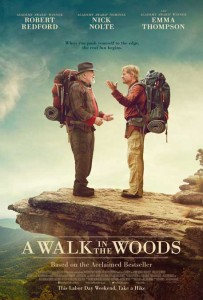 Most of the film was shot near Atlanta and the environs of the North Georgia woods, in particular Stone Mountain Park. In his sixth collaboration with the director, cinematographer John Bailey, who had also shot Redford’s directorial debut, lensed the movie. He shot all the trail scenes on 35mm film, although it is harder to shoot in 35mm these days largely because there are few labs to process it.
Most of the film was shot near Atlanta and the environs of the North Georgia woods, in particular Stone Mountain Park. In his sixth collaboration with the director, cinematographer John Bailey, who had also shot Redford’s directorial debut, lensed the movie. He shot all the trail scenes on 35mm film, although it is harder to shoot in 35mm these days largely because there are few labs to process it.
“We argued to our financier that it would enhance the film for a couple of reasons. John and I both feel that there is something ineffably different about 35mm, especially when seen on the big screen,” explained Kwapis. “We also shot in 35mm for a very specific technical reason. We did not have the means to control light in the woods to a great degree. You can’t control those hot spots when the sun bursts through, but you can control those things later in the color-timing process and you can better control them if you shoot on 35mm film because 35mm negative will always have some information there, even if the sun kind of burns out a spot. In the digital realm, there is simply no information.”
The director and cinematographer have developed a shorthand over the course of their multiple projects together. Film lovers, they often talk about movies as reference points. For A Walk in the Woods they talked about certain compositions in David Lean’s films, such as figures against landscapes.
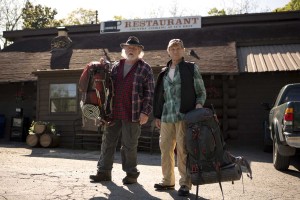 “We definitely have always tried to keep things grounded and realistic. We try to avoid camera angles that are quote… impossible,” shared Kwapis. “In A Walk in the Woods, the focus is on these two men, their faces, their physicality against majestic backdrops.”
“We definitely have always tried to keep things grounded and realistic. We try to avoid camera angles that are quote… impossible,” shared Kwapis. “In A Walk in the Woods, the focus is on these two men, their faces, their physicality against majestic backdrops.”
The duo plan shots and Kwapis loves to storyboard, but instead of sticking to an idea that was conceived in an office weeks earlier, the goal is to have those ideas in your back pocket, but then to forget about it and “open your eyes and see what’s right in front of you.”
Kwapis elaborated, “The real adventure is when you get on location and you’re on a hunt for an image that tells the story, or sums up the theme, or illuminates the character. If you pre-visualize too strictly, you are going to miss the opportunity to let something occur to you in the moment.”
Much of Kwapis’ work with Bailey is about creating the conditions for great performance, which segues into the work of editor Carol Littleton, who worked with the director once before.
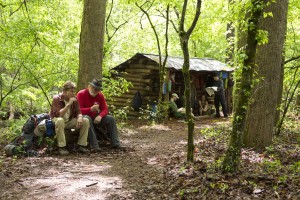 “Carol is a serious hiker herself,” noted Kwapis. “She not only has the ability to find the absolute right performance moments, but she is smart enough to know when not to cut. Carol is brilliant in knowing how to let something play and not getting in the way of it.”
“Carol is a serious hiker herself,” noted Kwapis. “She not only has the ability to find the absolute right performance moments, but she is smart enough to know when not to cut. Carol is brilliant in knowing how to let something play and not getting in the way of it.”
In both film and television editing, Kwapis is frustrated that characters are often “choked by the editing, giving them room to breathe – those extra moments, those pauses – those are the things an audience needs to bank in the back of their minds so that by the end of the picture, they feel like they have lived with these characters. That’s what makes a story feel lived in.”
When the director saw Littleton’s cut of the climatic nighttime scene, where Bryson and Katz are stranded on a ledge, he said, “Oh, we’re done with this scene. I don’t think we changed it at all. Carol’s editor’s cut of that scene is what is on the screen.”
Kwapis thought Littleton would hold on Redford if his character had significant dialog, but was pleasantly surprised when she favored Nolte’s reaction. The editor felt holding on Nolte was actually “where the life of that moment existed.” Kwapis acknowledged, “It’s a level of craft that’s rare and deep.”
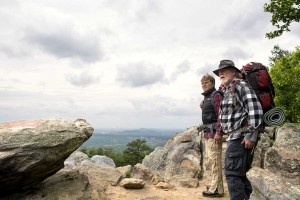 First assistant editor Julie Garces, who has other editing credits, did a lot of cutting on the film. Littleton, who prides herself in mentoring, generously recommended that Garces get a promotion to editor. Littleton felt that with 36 credits, she did not need another editing credit.
First assistant editor Julie Garces, who has other editing credits, did a lot of cutting on the film. Littleton, who prides herself in mentoring, generously recommended that Garces get a promotion to editor. Littleton felt that with 36 credits, she did not need another editing credit.
Kwapis has worked with production designer Gae Buckley on four films. “To me she is the heartbeat of the picture. I’m thrilled she was able to do this one,” said Kwapis. “We had to really be creative and plan things down to the foot.”
The team’s mandate was to create a road movie without moving far. Scouting with a location manager, part of Buckley’s job was to familiarize herself with the Appalachian Trail from north Georgia into the middle of Virginia, making sure that they could find areas that looked like different sections of the trail, all while remaining in and around Atlanta where the company was required to shoot. They needed to find locations in the area that could stand in for places along the journey, such as Gatlinburg, Tennessee.
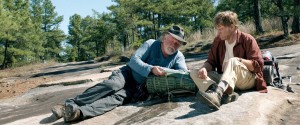 “She had to become a bit of a naturalist herself,” explained Kwapis. “Now, what made life even more challenging is that we scouted in late winter when there were no leaves on the trees. By the time we got around to shooting, spring was in bloom and you couldn’t see 50 feet ahead of you.”
“She had to become a bit of a naturalist herself,” explained Kwapis. “Now, what made life even more challenging is that we scouted in late winter when there were no leaves on the trees. By the time we got around to shooting, spring was in bloom and you couldn’t see 50 feet ahead of you.”
Although he had never worked with her before, Kwapis thought Atlanta-based costume designer Leigh Leverett did a “fantastic job.” For both the production and costume designers it was important to make sure things looked as authentic as possible.
“There are a lot of people who not only love Bill Bryson’s book, but swear by it,” said Kwapis. “We all felt an obligation to those Bryson devotees to get it right, to make sure the look of the trail and the look of the hikers themselves felt right. It seems like a simple thing, but it’s not.”
Singling out first assistant director Steve Dunn, Kwapis commented, “His credits are quite remarkable. He’s worked with people who direct character-driven stories. He’s worked a lot with Lasse Hallström. He’s worked with Robert Altman. And he worked on a Lasse Hallström film that Robert Redford was in. It was nice that there was someone on board that Bob had worked with in that capacity.”
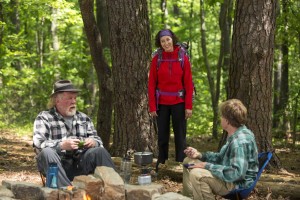 It was important for the director to musically bring Bryson and Katz into a contemporary musical world. With characters in their 70s, Kwapis did not want the music to feel like a nostalgic throwback by playing oldies. He wanted to find a songwriter or a band that could help represent the majesty of the Appalachian Trail. He found what he wanted in the L.A.-based band Lord Huron.
It was important for the director to musically bring Bryson and Katz into a contemporary musical world. With characters in their 70s, Kwapis did not want the music to feel like a nostalgic throwback by playing oldies. He wanted to find a songwriter or a band that could help represent the majesty of the Appalachian Trail. He found what he wanted in the L.A.-based band Lord Huron.
“A music blogger once wrote Lord Huron’s music is what you would expect to hear if you walked into a national park. It’s true because Lord Huron’s sound has a special quality. The textures of the natural world are in their songs,” said Kwapis. “There is a wonderful score by Nathan Larson, but there are also songs by one group that form a thread throughout the story, the same way Simon and Garfunkel’s songs provided a thread throughout The Graduate.”
In postproduction, Kwapis worked with New York-based supervising sound editor and rerecording mixer Ron Bochar who had worked on many major features over the years. The crew captured great sound on location, but Bochar wanted to make sure the environment was accurate.
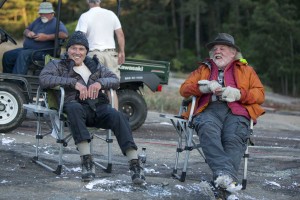 “This is a small, but important thing to me,” explained Kwapis. “There are different birds who make their homes at different places along this trail. Ron created a sort of ornithological map so that in the mixing we heard birds that are specific to North Carolina when our characters are in North Carolina. We heard birds that are specific to Tennessee in Tennessee. I’m proud of the fact that the birds are geographically accurate.”
“This is a small, but important thing to me,” explained Kwapis. “There are different birds who make their homes at different places along this trail. Ron created a sort of ornithological map so that in the mixing we heard birds that are specific to North Carolina when our characters are in North Carolina. We heard birds that are specific to Tennessee in Tennessee. I’m proud of the fact that the birds are geographically accurate.”
Birds play an important part in the book. In one chapter Bryson talks about how many songbirds have been lost over the past century that once flourished in the eastern woods. One scene that is very magical for the director occurs early on in the story when Bryson leaves his New Hampshire home for a walk and stumbles upon the Appalachian Trail where he gets the idea to hike it.
“The location we shot in Atlanta, where Bryson happens upon the trail, was a songbird sanctuary,” according to Kwapis. “I didn’t know it at first. As we were shooting the first couple of shots, there’s no dialog, just shots of Bob walking through a wooded area and looking at a sign. After a few takes, I realized the track was dense with birdsong. That’s when the location manager said we were in a designated songbird sanctuary. If you listen to that scene, it’s delightful. It’s appropriately magical because he is about to get the call of the wild.”





